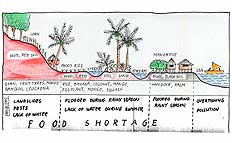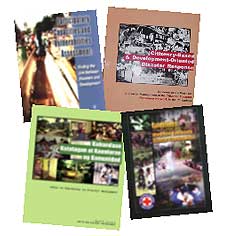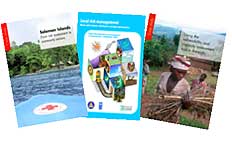CRA toolkit menu
 |
|
Community Risk Assessment methodologies and case studies |
The following methodologies and case studies were collected and analysed by Cape Town University, Ben Wisner and the ProVention Consortium Secretariat as part of a ProVention project. Guidance notes give a brief overview of the case studies and methodologies and allow users to identify the most appropriate assessment methodologies and applications. A search tool allows users to carry out searches in methodologies and case studies according to a wide range of predetermined categories. A glossary gives brief definitions of key terms used in the guidance notes and in the search tool. For further information about community based disaster risk management and participatory tools, check our additional links. |

Image: Center for Disaster Preparedness |
Register of methodologies
In the Toolkit, a distinction is made between five different types of methodological resources:
 |
|
Two additional sections deal with community-based climate adaptation tools and lessons learned on the use of CRA methodologies.
NB: The guidance notes for methods marked with an asterisk* will be developed at a later stage. These methods are not yet included in the search tool.
Comprehensive manuals
"How to do a VCA. A practical step by step guide for RC/RC staff and volunteers" - International Federation of Red Cross and Red Crescent Societies
full document in English PDF, 3.3MB) ((in French - PDF 3.4MB) (in Arabic - PDF 1.8MB) / guidance noteParticipatory Capacities and Vulnerabilities Assessment: Finding the Links Between Disasters and Development - Oxfam (PDF, 4.9MB)
full document (PDF, 4.9MB) / guidance noteCommunity-Based Disaster Risk Management Field Practitioners' Handbook, Part 2 chapter 3: Participatory Disaster Risk Assessment (PDRA) & Part 2 chapter 4: Participatory Disaster Risk Management Planning - Asian Disaster Preparedness Center.
full document (PDF, 1.2MB) / guidance noteCitizenry Based Development Oriented Disaster Response - Center for Disaster Preparedness Inc, Philippines
full document (see chapter 3 - PDF, 6.7MB) / guidance noteCommunity-Wide Vulnerability and Capacity Assessment, CVCA - Government of Canada, Office of Critical Infrastructure and Emergency Preparedness
full document (PDF, 0.3MB) / guidance noteParticipatory Vulnerability Analysis, A Step-by-Step Guide for Field Staff - ActionAid
full document (PDF, 0.2MB) / guidance noteWorking with Women at Risk: Practical Guidelines for Assessing Local Disaster Risk - International Hurricane Center
full document in English PDF, 1.3MB) (in Spanish - PDF 1.1MB) / guidance noteHousehold Livelihood Security Assessments: A Toolkit for Practitioners - CARE
full document (PDF, 3.2MB) / guidance noteParticipation by Crisis-Affected Populations in Humanitarian Action. A Handbook for Practitioners. (Chapter 3: Assessment, Chapter 4: Design) - ALNAP
full document (PDF, 1MB) / guidance noteReducing risk in our communities - Tearfund
full document (PDF, 1MB) / guidance noteCentral Asia Earthquake Safety Initiative, Urban Risk Reduction Framework - GeoHazards International
full document (Word, 0.2MB) / guidance noteGestion Comunitaria de Riesgos - Foro Ciudades para la Vida,
full document (PDF, 5.7MB) / guidance note (in English / Spanish).
Step-by-step manuals
*Participatory Impact Assessment, A Guide for Practitioners - Feinstein International Center, Tufts University
full document in English (PDF, 2.7MB)*Weathering the storm: participatory risk assessment for informal settlements - Disaster Mitigation for Sustainable Livelihoods Programme, University of Cape Town
full document in English (PDF, 5MB)Child Oriented Participatory Risk Assessment and Planning (COPRAP) - Center for Positive Future, Center for Disaster Preparedness
methodology in English (PDF, 0.7MB) / guidance note / trainer's manual (PDF, 6.6MB)VCA toolbox with reference sheets - International Federation of Red Cross and Red Crescent Societies
full document in English (PDF, 5MB) / guidance noteGuidelines for Community Vulnerability Analysis, An Approach for Pacific Island Countries - UNDP/UNDHA/SPDRP
full document (PDF, 4.4MB) / guidance noteMake that change, Community Based Disaster Management, Facilitators Manual - International Federation of Red Cross and Red Crescent Societies
full document (PDF, 2.5 MB) / guidance noteCommunity Vulnerability Assessment Tool - NOAA
full document (PDF, 0.3MB) / guidance noteHazard, Risk Vulnerability Analysis Tool Kit - British Columbia, Provincial Emergency Program
full document (PDF, 1.5MB) / guidance notePreparing for disaster, A community-based approach - Philippine National Red Cross/Danish Red Cross
full document (PDF, 3.5MB) / guidance note
Guidelines
What is VCA? An Introduction to Vulnerability and Capacity Assessment" - International Federation of Red Cross and Red Crescent Societies
full document in English PDF, 1.3MB) (in Spanish - PDF 1.1MB) (in French - PDF 1.1MB) (in Arabic - PDF 1.1MB) / guidance noteCommunity-based Risk Screening Tool – Adaptation and Livelihoods (CRiSTAL) - IISD, IUCN, SEI-US, Intercooperation, financed by the Swiss Agency for Development and Cooperation (SDC)
brochure (PDF, 3.3MB) / manual (PDF 1.4MB) / spreadsheet (excel, 0.4MB) / guidance noteRisk Analysis, a Basis for Disaster Risk Management: Guidelines - GTZ
full document (PDF, 2.7MB)/ guidance noteVulnerability and Capacity Assessment, An International Federation Guide - International Federation of Red Cross and Red Crescent Societies, 1999
full document (PDF, 4.2 MB) / guidance noteVulnerability and Capacity Assessment Toolbox - International Federation of Red Cross and Red Crescent Societies
full document (PDF, 0.2MB) / guidance noteAssessing Resilience and Vulnerability in the Context of Emergencies: Guidelines - Victorian Government (Department of Human Services)
full document (PDF, 0.2MB) / guidance noteAssessing Resilience & Vulnerability: Principles, Strategies and Actions. Guidelines - Emergency Management Australia
full document (PDF, 1MB) / guidance note
Overviews
Disaster risk reduction. Mitigation and Preparedness in development and emergency programming. HPN Good Practice Review (Chapter 4: Project Planning) - John Twigg
full document (PDF, 0.4MB) / guidance noteSocial vulnerability, Sustainable Livelihoods and Disasters, Report to DFID - Terry Cannon, John Twigg and Jennifer Rowell
full document (Word, 0.8MB) / guidance note*Climate Proofing Tool, Strengthening local adaptation and mitigation capacities in community-level development projects. Working Paper, Version 3. June 2009, HEKS -
full document (in English - PDF 0.4MB) (in French - PDF 0.6MB) (in Spanish - PDF 0.4MB)
Training manuals
Guide to Vulnerability and Risk Assessment - UN Disaster Management Training Program
full document (PDF, 1.5MB) / guidance noteVCA training guide - Classroom training and learning-by-doing
full document (PDF, 2.4MB) / guidance note
Compendia of Community Based Adaptation Tools
Lessons learned
"Vulnerability and capacity assessment: Lessons learned and recommendations" - International Federation of Red Cross and Red Crescent Societies
full document (in English PDF, 1.4MB) (in Spanish - PDF 1.7MB) (in French - PDF 1.7MB) (in Arabic - PDF 0.6MB)
Compendium of case studiesWe have distinguished two kinds of case studies in the CRA toolkit.
NB: The guidance notes for case studies marked with an asterisk* will be developed at a later stage. These case studies are not yet included in the search tool. |
|
The case studies below are sorted by region
Africa
Ethiopia and Kenya - Participatory Risk Mapping for Targeting Research and Assistance: With an Example for East African Pastoralists
Case study (PDF, 0.2 MB) / case study cover / explanatory noteKenya - An Investigation into Community Perceptions and Response to Flood Risks in Western Kenya
Case study (PDF, 0.3 MB) / guidance noteLesotho - Vulnerability and Capacity Assessment in Maqoala, Malebanye, Ha Sankatana and Ha Mapotsane
Case study (PDF, 2.5 MB) / explanatory noteLesotho - Vulnerability and Capacity Assessment in Mafeteng and Quthing
Case study (PDF, 0.3 MB) / guidance noteMadagascar - Community Risk Assessments, Disaster Preparedness and Mitigation Plan (DPMP)
case study (PDF, 1 MB) / guidance noteMozambique - Assessing the Role of Local Institutions in Reducing the Vulnerability of At-Risk Communities in Búzi, Central Mozambique
case study (0.8MB) / explanatory noteMozambique - Local Livelihoods Risk Assessment: Construction and Operation of Mphanda Nkuwa Hydroelectric Dam
case study (0.4MB) / explanatory noteRwanda - Using the vulnerability and capacity assessment tool in Rwanda
Case study (PDF, 1.6 MB) / explanatory noteSierra Leone - Vulnerability and Capacity Assessment (VAC) Report for 19 Communities in Kono and Tonkolili Districts
case study (PDF, 0.5 MB) / guidance noteSouth Africa - Fire Hazard and Vulnerability in Imizamo Yethu Informal Settlement
case study (PDF, 0.8 MB) / guidance noteSouth Africa - Community Risk Assessment in Haarlem, Uniondale, Eden District
case study (PDF, 0.1 MB) / guidance noteSouth Africa - A transect walk undertaken in the informal settlement of Itereleng to observe community vulnerability
case study (PDF, 2.6 MB) / explanatory noteZambia - Vulnerability Capacity Assessment: Sinazongwe District
case study (PDF, 0.6 MB) / guidance note (this guidance note has been updated with new information in March 2008)Zimbabwe - Beating Hunger: The Chivi Experience
case study (PDF, 3.9 MB) / guidance note (this guidance note has been updated with new information in February 2008)Zimbabwe - Impact Assessment of the Zimbabwe Dams and Gardens Project
case study (PDF, 2 MB) / explanatory note
Asia
Bangladesh - Hazard Mapping and Vulnerability Assessment for Flood Mitigation
case study (PDF, 0.5 MB) / guidance noteCambodia - Cambodian community based flood mitigation and preparedness project
case study (PDF, 0.1 MB) / guidance noteIndia - Development & risk reduction in hazard-prone communities of Andhra Pradesh in India
case study (PDF, 0.6 MB) / guidance noteIndia - Community-based disaster risk reduction in the Indian State of Bihar
case study (PDF, 0.6 MB) / guidance noteIndia - Peripheral Heartland: Floods in Eastern Uttar Pradesh
case study (PDF, 2.8 MB) / explanatory noteIndia - Challenges and Prospects for Adaptation: Climate Change & Disaster Risk Reduction in Coastal Tamil Nadu
case study (PDF, 0.7 MB) / guidance noteLao PDR - Community-Based Disaster Management Project in Champasack District
case study (PDF, 0.2 MB) / guidance noteNepal - Flood Disaster Impacts and Responses in Nepal Tarai’s Marginalised Basins
case study (PDF, 4 MB) / guidance noteNepal - The Snake and the River Don’t Run Straight: Local knowledge on disaster preparedness in the Eastern Terai of Nepal
case study (PDF, 0.8 MB) / guidance notePakistan - Becoming a Model: Community Managed Flood Preparedness Project
case study (PDF, 0.6 MB) / guidance note (this guidance note has been updated with new information in February 2008)Pakistan - Navigating the Contours of the Pakistani Hazardscapes: Disaster Experience versus Policy
case study (PDF, 2.6 MB) / explanatory notePakistan - Herders of Chitral: The Lost Messengers? Local Knowledge on Disaster Preparedness in Chitral District
case study (PDF, 0.6 MB) / guidance notePhilippines - Enhancing Local Government Unit Capacities in Disaster Preparedness, Prevention & Mitigation
case study (PDF, 0.6 MB) / guidance notePhilippines - Child Oriented Participatory Risk Assessment and Planning in San Mateo, Rizal
case study (PDF, 0.5 MB) / guidance noteSri Lanka - Matara Vulnerability and Capacity Assessment Report
case study (PDF, 0.2 MB) / guidance noteTurkey - Umraniye Women's Outreach Community Disaster Preparedness Project
case study (PDF, 2 MB) / guidance note (this guidance note has been updated with new information in March 2008)Turkey - Vulnerabilty and Capacity Assessment, Faik Pasa and Mirali Neighbourhood Project
case study (PDF, 2.1 MB) / guidance note
Latin America
Belize - Belize Red Cross Vulnerability and Capacity Assessment Workshop
case study (PDF, 0.4 MB) / guidance noteBelize - Vulnerability and Capacity Assessment in Ladyville and Caledonia
case studies (PDF, 2 MB) / guidance noteBrazil - Vulnerability and Resilience: Case studies and analysis in urban and rural areas (Minas Gerais and Rio de Janeiro)
case studies (PDF, 0.6 MB) / explanatory noteCosta Rica - Vulnerability and Capacity Assessment in Linda Vista (La Unión) and El Meco (Ciudad Quesada)
case studies (PDF, 6.6 MB) / guidance note [English] [Spanish]El Salvador - Program for Prevention and Mitigation of Flood Disasters in the Lower Lempa River Basin
case study (PDF, 0.3 MB) / guidance note (this guidance note has been updated with new information in August 2008)Guatemala - Communities Vulnerable to Disasters in the Metropolitan Area of Guatemala City
case study (PDF, 0.7 MB) / guidance noteGuatemala - Vulnerability and Capacity Assessments in the communities of Nuestra Señora del Carmen zona 12 and Anexo Forestal zona 13
case study (PDF, 7.4 MB) / guidance note [English] [Spanish]Guatemala - Emergency Capacity Building Project (ECB) Participatory Disaster Risk Reduction Model Guatemala Pilot
case studies (PDF, 0.7 MB) / guidance noteHonduras - Vulnerability and Capacity Assessment in Colonia Nueva Esperanza, Tegucigalpa, and El Zamorano community, Jamastrán, El Paraíso
case study (PDF, 6 MB) / guidance note [English] [Spanish]Mexico - A Community Participatory Approach for Disaster Prevention in the Municipality of Tlatlauquitepec, Sierra Norte de Puebla, Mexico
case study (PDF, 4 MB) / guidance notePeru - Capacity Building Workshop in Disaster Prevention and Risk Management for Communities of Caylloma District affected by the 2004 Cold Wave
case study (PDF, 1.8 MB) / guidance note (this guidance note has been updated with new information in February 2008)Trinidad & Tobago - Vulnerability Capacity Assessment, Speyside Community, Tobago
case study (PDF, 7.3 MB) / guidance noteVenezuela - Pilot Study of Community Based Disaster Management Strategy for Earthquakes
case study (PDF, 0.7 MB) / guidance noteVenezuela - Local and popular folklore and culture on hazard and vulnerability meets geographical information system for the risk reduction preparedness of the people of the Barrio San Antonio of Naiguatá, Estado Vargas
case study (PDF, 0.4 MB) / guidance note
Small island developing states
Cuba - Weathering the Storm: Lessons in Risk Reduction from Cuba
case study (PDF, 1 MB) / guidance note (this guidance note has been updated with new information in October 2008)Jamaica - Community Led Risk Assessment and Action Planning in White Horses
case study (PDF, 0.4 MB) / guidance noteSolomon Islands - Solomon Islands: from risk assessment to community actions
case study (PDF, 1.2 MB) / guidance noteVanuatu - Participatory methods of incorporating scientific with traditional knowledge for volcanic hazard management on Ambae Island
case study (PDF, 0.8 MB) / guidance note (this guidance note has been updated with new information in February 2008)Maldives - Findings of the Vulnerability and Capacity Assessment in Maduvvaree and Meedhoo
case study (PDF, 3.1 MB) / guidance note
Other countries
Country X - Vulnerability Capacity Assessment Community: Village A
case study (PDF, 0.2 MB) / guidance note
Other compendia of case studies
Vulnerability Assessment Techniques and Applications (VATA) - A Collection of Case Studies from the Americas
Action Aid Participatory Vulnerability Assessment - A Collection of Case Studies from Africa and Asia (PDF, 0.8 MB)

